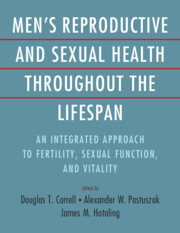 Men's Reproductive and Sexual Health Throughout the Lifespan
Men's Reproductive and Sexual Health Throughout the Lifespan from Section 3 - Clinical Evaluation and Treatment of Male Infertility
Published online by Cambridge University Press: 06 December 2023
Male factors significantly contribute to the issues faced by couples who are experiencing difficulties with conception. Management of the infertile male is complicated and based on a multitude of factors. Each couple is unique and has diverse issues, necessitating unique interventional approaches. Management can range from the optimization of lifestyle factors to treatment with surgery and medications. Several options exist in the medical optimization of the infertile, or subfertile male including treatment with gonadotropins (HCg, FSH), selective estrogen receptor modulators (i.e., clomiphene citrate), aromatase inhibitors (i.e., arimidex, letrozole), and prolactin altering agents (i.e., dostinex, bromocriptine). The use of the agents, both alone and in combination, is detailed in the current chapter.
To save this book to your Kindle, first ensure [email protected] is added to your Approved Personal Document E-mail List under your Personal Document Settings on the Manage Your Content and Devices page of your Amazon account. Then enter the ‘name’ part of your Kindle email address below. Find out more about saving to your Kindle.
Note you can select to save to either the @free.kindle.com or @kindle.com variations. ‘@free.kindle.com’ emails are free but can only be saved to your device when it is connected to wi-fi. ‘@kindle.com’ emails can be delivered even when you are not connected to wi-fi, but note that service fees apply.
Find out more about the Kindle Personal Document Service.
To save content items to your account, please confirm that you agree to abide by our usage policies. If this is the first time you use this feature, you will be asked to authorise Cambridge Core to connect with your account. Find out more about saving content to Dropbox.
To save content items to your account, please confirm that you agree to abide by our usage policies. If this is the first time you use this feature, you will be asked to authorise Cambridge Core to connect with your account. Find out more about saving content to Google Drive.